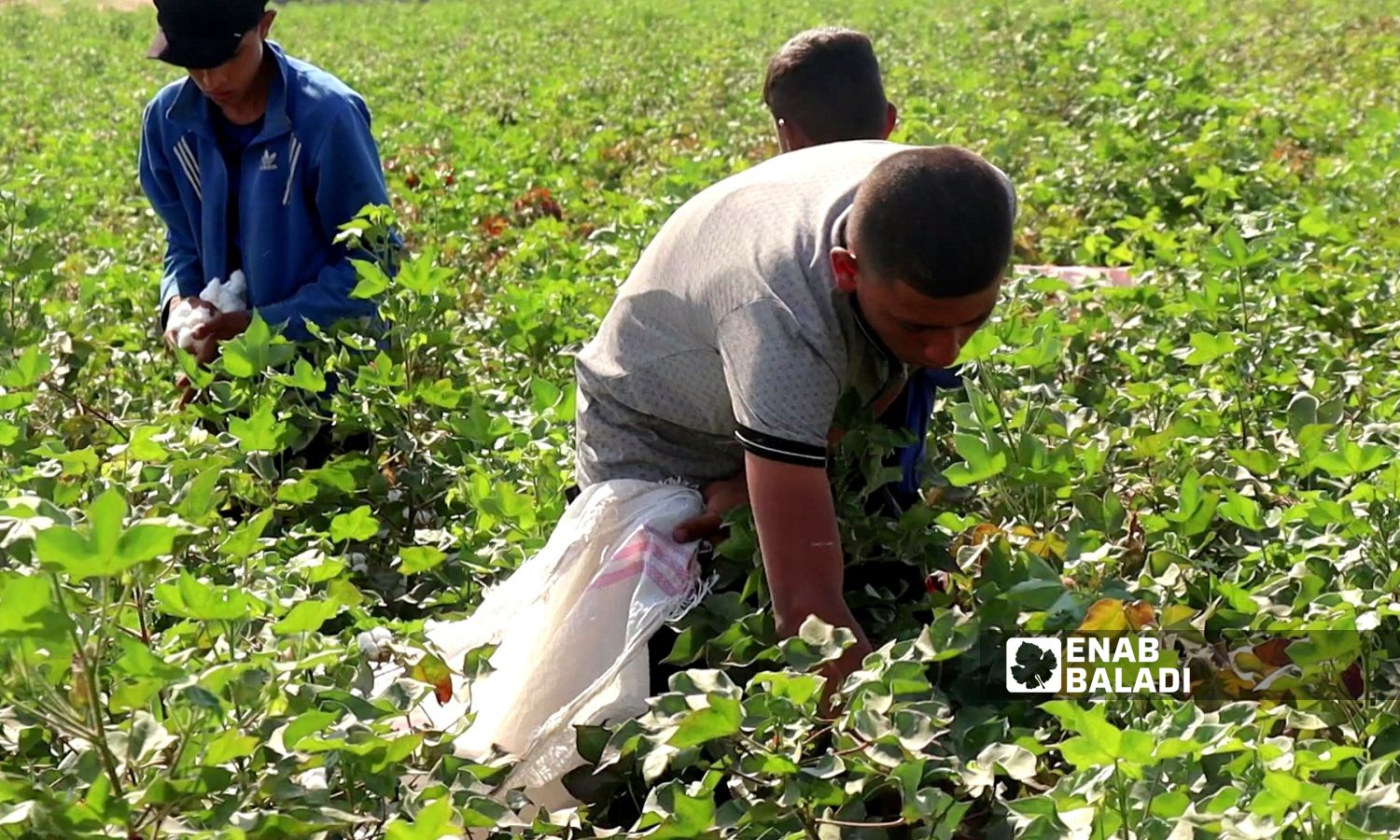



Enab Baladi – Ras al-Ain
The cotton harvest in the Ras al-Ain area, northwest of al-Hasakah, has been delayed due to workers’ dissatisfaction with the wages set by farmers, amid expectations for a weak agricultural season.
The delay has extended to over 15 days. Traditionally, cotton picking begins on September 20th each year, in a season eagerly awaited by many workers, as most of the 115,000 population rely on agriculture as a primary source of income.
Farmers and workers disagree over the wages for this year’s cotton harvest. Last year’s wages ranged between 80 and 100 US dollars, an amount agreed upon between the landowner and a working group manager for gathering a ton of cotton, which requires four to five workers over five days.
This season, farmers set wages between 60 and 75 dollars, causing dissatisfaction among workers who believe these rates do not cover their increasing living costs.
Ahmed Kamal, a cotton picker, expressed his dissatisfaction with the new wage, telling Enab Baladi that the amount is low compared to last year’s wages and the physical effort required for the work.
Samer Karim, another cotton picker, was surprised by the reduced wages amid rising prices of most goods since last year. He noted that wages last year were already low, but workers accepted them out of necessity.
Karim Mustafa, responsible for a group of 35 workers, stated that he has not worked with any landowner since the season started, demanding a change in rates to at least 100 dollars per ton.
He told Enab Baladi that the current wages are insufficient, as workers toil for long hours under burdensome conditions. He added that collecting a ton of cotton requires four to five days of hard labor, demanding considerable physical effort not commensurate with the offered wages.
He mentioned that, as a working group manager, he bears additional financial expenses such as transportation costs, considering the current wages inappropriate.
Conversely, farmers in the Ras al-Ain area complained about rising costs and declining cotton yields, as the infestation of cotton bollworm led to crop damage, forcing them to set picking rates aligned with their estimated costs.
Hussam Hassoun, a farmer from Hamid village east of Ras al-Ain, mentioned he could not increase cotton picking wages due to high expenses. He added that most cotton was severely damaged by the worm, affecting the crop’s quality and production volume.
He told Enab Baladi that farmers agreed on setting cotton picking rates between 60 and 70 dollars per ton to meet their financial obligations.
He pointed out that cotton cultivation requires significant expenses, including farming, fertilizers, and pest control, making it difficult to pay high picking wages.
Hassoun noted that current prices do not reflect the prevailing situation, as traders did not offer more than 500 dollars per ton, making any increase in picking rates hard to achieve under these economic conditions.
This year, the cotton bollworm threatened cotton crops in Ras al-Ain, affecting fields variably, with damage in some lands reaching 50%.
This small insect feeds on cotton leaves and fruits, impacting their growth and quality, with its spread attributed to various factors, including weather fluctuations providing an ideal environment for its proliferation.
Ziad Maliki, a local council spokesperson in Ras al-Ain, told Enab Baladi that cotton picking wages were set in cooperation with the Tribal and Farmers Councils and workers at 60 US dollars, with the possibility of increasing to 70 US dollars.
He explained that this rate was approved by the Tribal and Farmers Bureau in Ras al-Ain, ensuring it is fair for all parties involved.
In case the rate is inadequate, it may be replaced or increased if farmers and workers agree on a rate meeting their needs, according to Maliki.
He noted that the local council does not impose specific cotton picking rates but received a proposal from tribes and councils suggesting a 60-dollar wage for cotton picking.
The cultivated cotton areas decreased from 65,000 dunams in 2023 to 27,000 dunams this year, attributed to the decline in economic viability of cotton cultivation, due to rising production costs and lower crop yields.
Agricultural crops in Ras al-Ain face difficulties with marketing, trader control, and the absence of government entities purchasing strategic crops, similar to the 2023 wheat season.
The agricultural sector in Ras al-Ain and its neighbor Tal Abyad is troubled by desertification affecting hundreds of thousands of dunams, along with lands succumbing to sinkholes and collapses rendering them unusable, exacerbated by economic factors like high reclamation and water extraction costs, and human factors like groundwater depletion and neglect by responsible entities.
Ras al-Ain lies along the Turkish border, controlled by the Turkey-backed Syrian National Army (SNA), surrounded by fronts with the Syrian Democratic Forces (SDF), with the Turkish border being its only outlet.
if you think the article contain wrong information or you have additional details Send Correction